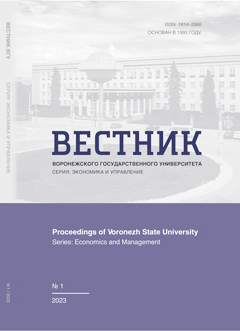Комплексный подход к анализу денежных потоков в условиях высокой неопределенности
Аннотация
Предмет. В статье исследуются вопросы аналитического обеспечения управления денежными потоками организаций. Рассмотрены методы анализа и мониторинга денежных потоков, позволяющие дать их комплексную оценку и представляющие наибольший интерес в условиях высокой неопределенности внешней среды. Обоснование выбора показателей для управления денежными потоками и сама методика их расчета, формирование системы показателей, необходимых для анализа, мониторинга и прогнозирования имеют особое значение, поскольку разные оценочные показатели приводят к неодинаковым результатам анализа и управленческим решениям.
Цели. Исследование возможностей разработки аналитической поддержки управления денежными потоками в условиях высокой нестабильности внешней среды.
Методология. В процессе исследования использовались методы сравнительного, логического, финансового, а также лингвистического анализа. В качестве основных объектов сравнительного анализа были рассмотрены показатели операционного денежного потока, свободного денежного потока, чистого оборотного капитала, чистого долга и их соотношений. В исследовании были использованы данные бухгалтерской и финансовой отчетности, справочно-аналитической системы СПАРК, раскрытий и презентаций для инвесторов, представленных на сайтах российских компаний с целью проведения сравнительного анализа подходов к определению ключевых финансовых показателей, характеризующих денежные потоки коммерческих организаций.
Результаты. Результаты исследования позволили сделать рекомендации по формированию комплексного подхода обеспечения аналитической поддержки управления денежными потоками с целью повышения обоснованности принимаемых решений. Сделан вывод о том, что управление денежными потоками требует межфункционального взаимодействия, учитывая взаимосвязь принимаемых операционных решений и их финансовых последствий. Это позволит контролировать основные процессы, влияющие на величину и динамику денежных потоков и разработать ключевые показатели эффективности, необходимые для их мониторинга и прогнозирования. В целях мониторинга разработанных инициатив целесообразно использовать информационную панель ключевых показателей, комплексно отражающих процесс создания и использования денежных средств.
Выводы. Выводы и рекомендации могут быть использованы для разработки комплексной модели управления платежеспособностью организации в условиях высокой нестабильности внешней среды и позволят повысить обоснованность принимаемых решений.
Metrics
Литература
Endovitskiy, D. A. (2014) Analysis of the investment attractiveness of the organization: scientific publication. Moscow: Knorus publ. (In Russian)
Efimova, O. V. (2020) [Formation of information on cash flows in order to make investment decisions]. Vestnik Voronezhskogo gosudarstvennogo universiteta. Seriya: Ekonomika i upravlenie = Bulletin of the Voronezh State University. Series: Economics and Management. 2, 116–130. (In Russian)
Kogdenko, V. G. (2017) [Methods of financial modeling based on published consolidated financial statements]. Ekonomicheskij analiz: teoriya i praktika Economic analysis: theory and practice. 16(7), 1269–1285. (In Russian)
Korobeynikova, L. S. & Shurygin V. N. (2020) [Comparative review of methodological approaches to the analysis of cash flows as a tool for ensuring financial security]. In: Proceedings of the International Scientific Anniversary Conference "The Faculty of Economics of the Voronezh State University is 90 years old". Edited by D. A. Endovitsky, N. G. Sapozhnikova. Voronezh State University. pp. 70–73. (In Russian).
Savelyeva, M. Yu., Alekseev, M. A. & Dudin, S. A. (2018) [The testing of preparation quality of cash flow statement preparation in Russian companies]. International Accounting. 21(9), 1024–1036. (In Russian).
Akten, M., Giordano M. & Scheiffele M. (2009) Just-in-time budgeting for a volatile economy. McKinsey on Finance. 31, 6–10.
Allen, F., & Carletti, E. (2010). An overview of the crisis: Causes, consequences, and solutions. International Review of Finance. 10(1), 1–26.
Batuman, B., Yildiz, Y. & Karan, M. B. (2021) The impact of the global financial crisis on corporate cash holdings: Evidence from Eastern European countries. Borsa Istanbul Review. 22(4), 678–687. DOI: 10.1016/J.BIR.2021.10.002
Becker, S. et al. (2016) Budgeting in Times of Economic Crisis. Contemporary Accounting Research. 4(33),. 1489–1517. DOI: 10.1111/1911-3846.12222
Bezemer, D. J. (2010) Understanding financial crisis through accounting models. Accounting, Organizations and Society. 35(7), 676–688.
Damodaran, A. (2020).Going to Pieces: Valuing Users, Subscribers and Customers. SSRN Electronic Journal.
Efimova, O. & Rozhnova, O. (2021) COVID-19: Financial impact and disclosure. Lecture Notes in Networks and Systems. 186, 205–213. DOI: 10.1007/978-3-030-66093-2_20
Fawzia, N. S., Kamaluddina, A. & Sanusib, Z. M.(2015) Monitoring Distressed Companies through Cash Flow Analysis. Procedia Economics and Finance. 28, 136–144. DOI: 10.24891/ea.16.7.1269
Ionescu, A–M. & Neghina, R–A. (2021) Management of Cash Flows during Covid-19. Journal of Eastern Europe Research in Business and Economics. Article number 870762. DOI: 10.5171/2021.870762.
Karzaeva, N. N. & Karzaeva, E. A. (2019) Methods for assessing solvency in the financial diagnostics system of an economic entity. International Transaction Journal of Engineering, Management, & Applied Sciences & Technologies. Paper ID: 10A19I.
Khan, S. U. (2022). Financing constraints and firm-level responses to the COVID-19 pandemic: International evidence. Research in international business and finance. 59, 101545. DOI: 10.1016/j.ribaf.2021.101545
Konstantinova, S. (2015) Analysis and modeling of industrial companies` cash flows under crisis conditions. Trakia Journal of Sciences. 13(1), 306–311.
Larionov, A. V. (2021) Methodological approach to the organization of monitoring of cash flow volatility. Finance: Theory and Practice. 25(3), 150–158. DOI: 10.26794/2587-5671-2021-25-3-150-158.
Mirza, N. et al.. (2020) Impact of Covid-19 on Corporate Solvency and Possible Policy Responses in the EU. The Quarterly Review of Economics and Finance. DOI: 10.1016/j.qref.2020.09.002
Soboleva, Y. P. et al. (2018) Monitoring of Businesses Operations with Cash Flow Analysis. International Journal of Civil Engineering and Technology (IJCIET). 9(11), 2034–2044.
Ritter, T. & Pedersen, C. L. (2020). Assessing Coronavirus’s Impact on Your Business Model. Harvard Business Review. April.

Это произведение доступно по лицензии Creative Commons «Attribution» («Атрибуция») 4.0 Всемирная.























